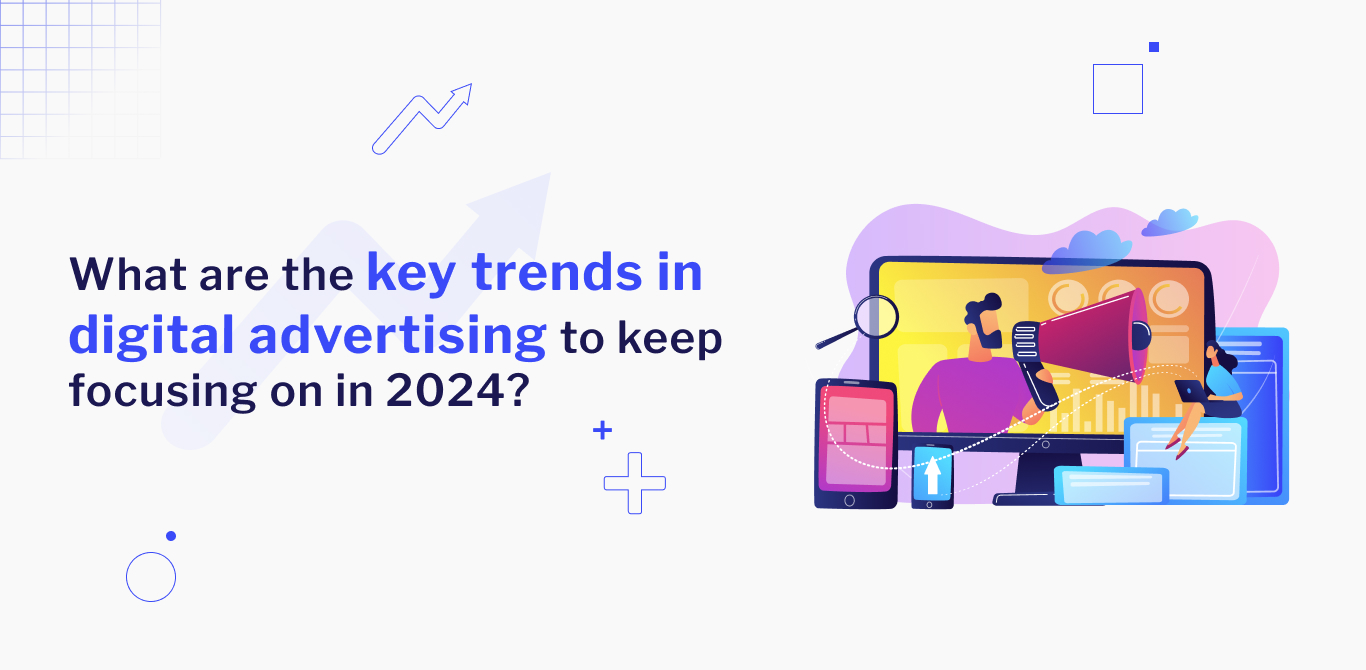The constantly changing digital world represents a future in which the combination of human creativity and technology will redefine engagement and effectiveness standards.
This year promises to be a turning point in the way companies interact with their customers, from the emergence of immersive video content that speaks directly to the pulse of our times to the data-driven insights pushing businesses towards a cookieless future.
Let’s explore the key trends that are shaping the future of digital marketing, brought to you by the best Digital marketing agency in India.
1. Data-Driven Marketing Evolution
In the digital age, the one who holds the most insightful data, wins. With the imminent departure of third-party cookies, marketers are pivoting towards a more intimate understanding of their audience through first-party data.
Tools and dashboards are helping businesses harness the power of data analytics for precise targeting and impactful customer journeys.
Tips for Mastering Data-Driven Strategies:
- Utilize Dashboards: Leverage platforms like Google’s Looker Studio to integrate and visualize your marketing data, making it easier to spot trends and make informed decisions.
- Embrace Structured Testing: Regularly test your strategies across different channels and audiences to understand what works best and why.
- Focus on First-Party Data: With cookies going away, collect and analyze data directly from your customers through surveys, newsletter sign-ups, and website interactions.
In 2024, embracing data not as a buzzword but as the core of your strategy will ensure your marketing efforts are not just a shot in the dark but a targeted arrow hitting the bullseye.
2. Enhancing Content Quality
In the era where content is king, EEAT (Experience, Expertise, Authoritativeness, and Trustworthiness) reigns supreme. Google’s inclusion of an additional ‘E’ for Experience underlines the shift towards valuing first hand expertise and real-world knowledge in digital content.
Elements to Enhance Your Content Quality:
- Showcase Real Experience: Share case studies, personal stories, and professional insights to demonstrate your expertise and experience.
- Build Authority and Trust: Cite reputable sources, secure guest posts on authoritative sites, and collect genuine reviews to bolster your site’s credibility.
- Continuously Update Content: Keep your content fresh and relevant by regularly reviewing and updating it to reflect the latest information and trends.
This nuanced approach to content creation prioritizes depth over breadth, encouraging a more meaningful connection with your audience.
3. Short-form Video Content Dominance
Why are TikTok, Reels, and YouTube Shorts captivating millions? It’s the art of storytelling compressed into a minute or less. Short-form video has emerged as a powerful medium to engage, entertain, and educate, fitting perfectly into the busy lives of modern consumers.
How to Leverage Short-Form Video:
- Be Authentic: The magic of short-form content lies in its authenticity. Let your brand’s personality shine through.
- Focus on Value: Whether it’s a quick tip, a laugh, or a moment of awe, make sure your content delivers value to your viewers.
- Encourage Engagement: Use calls-to-action to invite comments, shares, and likes, turning viewers into an active community.
In 2024, incorporating short-form videos into your marketing strategy isn’t just advisable; it’s essential to stay relevant and engaging.
4. Rise of Influencer Marketing
As traditional advertising becomes less effective, influencer marketing stands out for its ability to foster genuine connections between brands and consumers. The trend is clear: authenticity leads to trust, and trust drives engagement and sales.
Choosing the Right Influencer for Your Brand:
- Alignment with Brand Values: Select influencers whose personal brand and audience align with your own values and target market.
- Engagement Over Follower Count: A smaller, engaged audience is more valuable than a large, disinterested one. Focus on engagement rates.
- Micro-Influencers: Often, micro-influencers boast higher engagement rates and more niche audiences, making them ideal partners for targeted campaigns.
Embracing influencer marketing means moving beyond mere product placement, towards building genuine partnerships that resonate with audiences on a personal level.
5. Agility in Marketing Strategies
The digital landscape is likened to shifting sands – always on the move and unpredictable. Marketers are encouraged to adopt a mindset of agility and flexibility, allowing them to pivot strategies in response to real-time data and consumer feedback.
This dynamic approach is far removed from the rigid, long-term plans of yesteryear, embodying a more fluid, responsive way of engaging with the market.
Considerations for Agile Marketing:
- Stay Informed: Keep a close eye on market trends and consumer behavior, using insights to inform your strategy.
- Test and Learn: Embrace the cycle of testing, learning, and iterating, allowing you to refine tactics on the go.
- Customer Feedback: Regularly solicit and act on customer feedback to ensure your offerings meet evolving needs.
By remaining nimble, businesses can ensure they are not just reacting to changes but actively participating in the dialogue, shaping their strategies to align with the current landscape.
6. AI and Ethical Considerations
The integration of AI into digital marketing offers unprecedented efficiency and innovation, from automating mundane tasks to personalizing user experiences. However, with great power comes great responsibility. Marketers must navigate the fine line between leveraging AI for its benefits and ensuring ethical practices are upheld, particularly in relation to data privacy and user trust.
Ethical AI Practices:
- Transparency: Be open about how AI is used in your marketing strategies and how data is collected and utilized.
- User Consent: Ensure users are informed and consent to the use of their data, respecting their privacy and choices.
- Avoid Bias: Monitor AI algorithms to prevent unintended biases in your marketing content and recommendations.
Adopting AI responsibly ensures that technological advancements enhance user experiences without compromising ethical standards or trust.
7. Sustainability and Marketing
Sustainability is no longer just a buzzword but a critical component of modern business practices. Consumers are increasingly seeking out brands that demonstrate a commitment to environmental responsibility.
This shift necessitates that marketers integrate sustainability into their strategies, not just as a selling point but as a core value of their brand identity.
Strategies for Sustainable Marketing:
- Eco-friendly Practices: Adopt and promote practices that reduce your carbon footprint, from digital to physical operations.
- Sustainability Messaging: Communicate your sustainability efforts transparently and effectively, making sure they resonate with your target audience’s values.
- Product Lifecycle: Consider the environmental impact of your products or services throughout their lifecycle, from production to disposal.
Embracing sustainability not only contributes to the planet’s well-being but also aligns with the growing consumer demand for responsible business practices.
8. Diversifying Search Strategies
The way people search for information online is diversifying, with voice and image search gaining prominence alongside traditional text-based queries. This evolution requires marketers to think beyond the conventional search box, optimizing content for a variety of search methods to ensure visibility across all platforms.
Tips for Optimizing Multi-Modal Search:
- Voice Search Optimization: Incorporate natural language and question-based phrases in your content to cater to voice queries.
- Leverage Visual Content: Use high-quality, relevant images and optimize them with descriptive, keyword-rich alt text for image search.
- Structured Data: Implement structured data on your website to help search engines better understand and index your content.
By anticipating and adapting to these shifts in search behavior, marketers can ensure that their content remains accessible and relevant, no matter how potential customers are searching.
By weaving these strategies into your digital marketing approach, you ensure not only staying ahead in the game but also aligning with ethical, sustainable, and consumer-friendly practices that define the future of marketing.
Conclusion: Navigating the Future of Digital Marketing With GV
As we summarize the core of digital marketing trends for 2024, it becomes evident that the magic occurs at the meeting point of technology, creativity, and data-driven insights.
Global Vincitore, one of the Best digital marketing agencies in India provides businesses with strategies that are not just current but also forward-thinking.
We are prepared to lead businesses of any shape or form through the revolutionary waves of 2024 and beyond with our dedication to creating digital experiences that connect with audiences throughout the globe.
Frequently Asked Questions
Q1. Describe digital advertising in detail.
A. The promotion of goods or services using digital channels like websites, social media platforms, email, search engines, and mobile apps is known as digital advertising. It includes email marketing, search engine marketing (SEM), social media marketing, display ads, and video ads, among other formats.
Q2. In contrast to traditional marketing, what are the advantages of digital advertising?
A. Compared to traditional advertising, digital advertising has a number of benefits, such as the capacity for accurate targeting, real-time performance tracking, cost effectiveness, adaptability in ad forms, and the potential to reach a worldwide audience. Digital advertisements can also be tailored to target audiences based on their interests, behaviors, and demographics, which increases interaction and conversion rates.
Q3. How can digital ads target the work?
A. Digital advertising platforms employ machine learning algorithms and data analytics to target advertisements to certain audiences based on browsing history, demographics, location, hobbies, and online behavior, among other variables. The efficacy of the campaigns is increased since this targeting makes sure that advertisements are shown to people who are most likely to be interested in the goods or services being marketed.




